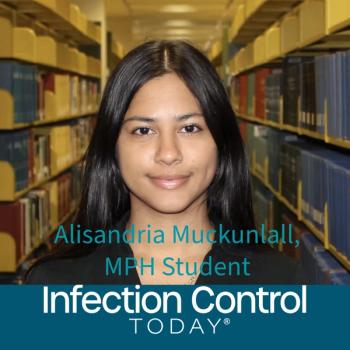In March of 2020, health care workers in the United States started universally masking with medical (eg, surgical) masks in health care settings for COVID-19 for all patient interactions. This change was unprecedented since, prior to the COVID-19 pandemic, studies in health care workers had not shown an advantage in terms of acquiring or spreading respiratory pathogens with surgical mask use. Indeed, prior the spring of 2020, only surgeons and affiliated staff routinely wore surgical masks in the operating room, mainly to protect the surgeon’s face from sprays or splashes (with a Cochrane review failing to demonstrate a reduction in wound infections from surgeon masking). Finally, prior to COVID-19, health care workers also wore fit-tested N95 masks (also called respirators) when treating patients with tuberculosis, an airborne pathogen. At this point, SARS-CoV-2’s main mode of transmission seems to via airborne particles and respiratory droplets.
However, given that Hong Kong and Singapore health care workers had already started universally masking in spring 2020, the United States followed suit in March of 2020. A paper from the Boston health care system in July 2020 showed a correlation between universal mask use among health care workers and SARS-CoV-2 positivity rates. Although causation could not be established, N95 use when testing or treating patients with presumed or confirmed COVID-19 was employed simultaneously, and testing algorithms can change after masking is instituted. Universal masking of the public was also recommended by the Centers for Disease Control and Prevention on April 3, 2020, because, as data on SARS-CoV-2 were being gathered, various interventions made sense out of the precautionary principle, sometimes in the absence of rigorous science supporting them. Indeed, our group wrote 1 of the first papers calling for universal face masks for COVID-19 around the time of the CDC recommendation.
Surgical and cloth masks had never been employed before to protect an individual from a virus that can spread by airborne particles. However, our group has a hypothesis that use of the commonly employed face masks may reduce the viral inoculum and lead to less severe disease early on in the pandemic, and that hypothesis garnered subsequent evidence. For instance, a Hong Kong study showed that surgical masks did not decrease transmission but increased asymptomatic infection. A study in primates showed that the higher the dose of SARS-CoV-2, the greater the severity of disease. And NIH researchers provided evidence that the humidity behind cloth masks may lessen the severity of disease. However, the best way to reduce severity of disease after vaccines were widely available was to get vaccinated, so this theoretical benefit of surgical masks is immaterial at this point in the pandemic. The next question is whether masks (worn by health care workers or the public) reduce transmission to other individuals or to the wearer.
Population Level Data
In terms of population level data, the largest cluster randomized study of mask wearing, conducted in 600 villages in Bangladesh, showed a small but statistically significant benefit—among people who consistently used masks—where 7.6% reported symptomatic infections compared to 8.6% in the control group. For the endpoint of both "self-reported COVID-like symptoms" and "positive COVID serology test" the absolute reduction was only 0.08% (0.76% in control, 0.69% in treatment). Moreover, a re-analysis of the raw data from the study showed even that small benefit was not found. Other randomized control trials (RCTs) prior to the COVID-19 pandemic also did not show the effectiveness of face masks in reducing the spread of respiratory pathogens. Observational studies have not convincingly showed that mask mandates changed outcomes in the U.S. that had them compared to states who did not, either in terms of cases or hospitalizations, after vaccines were available. Most well done studies evaluating mask mandates do not show an association between mask mandates and the containment of spread or hospitalizations.
Studies performed by the CDC which did not control for vaccination rates in the communities compared were confounded, since communities with higher vaccination rates had less COVID-19 transmission everywhere, including in schools, and those same communities were more likely to have mask mandates. A study in Arizona published in the CDC MMWR concluded that schools without mask mandates were 3.7 more likely to have COVID-19 outbreaks than schools with mask mandates by studying schools in Maricopa and Pima Counties. However, more than 90 percent of schools in the “no mask mandate” group were in Maricopa County, an area that has significantly lower vaccination rates than Pima County. During the Omicron surge, even in places like Nevada where all restrictions had been lifted, cases dropped at the same rates as places with reimposed mask mandates. During the Delta surge, California counties with mask mandates fared no better than those without mask mandates in terms of cases and hospitalizations if vaccination rates were similar.
Does Universal Surgical Mask Wearing Protect Others?
Basically, the idea that universal surgical mask wearing—as employed by health care workers in all patient care settings since the spring of 2020—has not been demonstrated to protect others by observational studies and randomized controlled trials since the pandemic started. Moreover, randomized trials or systematic reviews conducted prior to the COVID-19 pandemic among health care workers did not show a benefit in surgical masking in health care settings for the spread of respiratory pathogens (even those predominantly spread by droplets). A randomized trial published in The Journal of American Medical Association (JAMA) in 2009 showed no benefit in the arm of health care workers randomized to universal surgical masking for protection from influenza. A randomized trial among Japanese health care workers of surgical mask wearing published in the American Journal of Infection Control in 2009 showed no protective benefit against acquiring the common cold.
Is Mask-Wearing Risk-Free?
Finally, universal mask wearing in health care worker settings is not an entirely benign intervention. A study in 2013 randomized primary care doctors (n = 1030) to mask wearing and non-mask wearing during clinical consultations in public primary care clinics in Hong Kong. Doctors wearing a facemask during these routine interactions had a significantly negative impact on the patients’ perception of doctor empathy. In the more established doctor-patient relationships, the negative effects of perceptions of doctor empathy were even more pronounced. A study during the COVID-19 pandemic, published in 2021, describes some of the negative impacts of universal mask wearing on the physician-patient relationship, including hiding of facial expressions, subtle tonal inflections, and voice modulation. Finally, a randomized study of surgeons wearing clear masks versus standard surgical masks, published in The Journal of American Medical Association JAMA Surgery in 2021, showed that patients appreciated the visualization of their surgeons’ faces through clear masks, citing improved communication, trust, and a perception of increased empathy.
When Should Masks be Worn?
Continued standardized respiratory precautions during aerosol-generating procedures should be continued for COVID-19 in the health care setting if a patient tests positive for SARS-CoV-2 or if the patient’s status is unknown. Moreover, use of a respirator mask by health care workers when interacting with a patient with COVID-19 should certainly be continued.
However, universal surgical mask wearing with standard patient interactions in the health care setting does not seem to have evidence behind it in protecting either the health care worker or patients from respiratory pathogens, including SARS-CoV-2, via a critical appraisal of the data. Discontinuation of this practice at this stage of the pandemic seems indicated, with continued precautions as listed above, as we learn to “live with COVID-19,” including in health care settings, moving forward.







